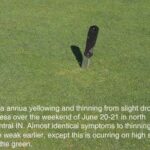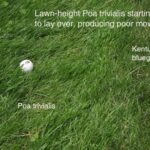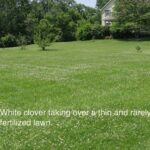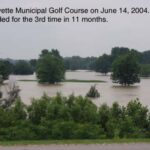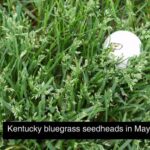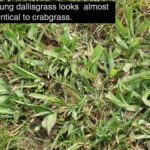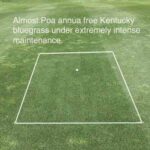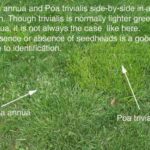Zac Reicher

Finicky Poa annua Yellowing and Thinning on Greens
In spite of the cool and dry weather, Poa annua continues to yellow and sometimes thin on golf greens. Last week Poa annua was thinning and dieing in low areas from too much water, heat, and humidity (photo). However, the cool dry weather over the weekend allowed for maximum water loss through evapotranspiration. Plus since many irrigation systems were […]
Summer stress of Poa annua and Poa trivialis in Lawns and Sports Fields
Poa annua (annual bluegrass) and Poa trivialis (rough bluegrass) in athletic fields and lawns are starting to show signs of stress. The signs of stress include laying over (poor mow-ability), yellowing, and thinning. Patches of these fine-bladed grasses seemingly die overnight with even a minimum of drought stress. Though these grasses may have blended in with the desired turf […]
White Clover in Golf Courses, Sports Turf, and Lawns
The small white flowers of white clover are very visible right now and it may appear that clover is taking over, especially under-fertilized turf areas. Clover is a legume and is very competitive under low N conditions, so increasing annual N is best method for long-term control. The temptation is to apply a herbicide now […]
Dealing With Flood Damage
Though flooding damage so far this year is not as bad as last year, a number of areas have been hard hit with rainfall the last week (see the photo of Lafayette Municipal Golf Course). We don’t expect damage to be as extensive as last summer given the slightly lower temperatures, but some areas will […]
Doug Richmond Joins Turf Program in Entomology Research
Dr. Doug Richmond has recently accepted the turfgrass entomology faculty position at Purdue University. Doug is the first of the projected six positions of Purdue’s initiative on sustainable urban ecosystems. Dr. Richmond joins the Turf Program after completing his M.S. and Ph.D. and Ohio State University in Columbus under Dr. David Shetlar and his Post […]
Midwest Regional Turf Field Day on July 27
The Midwest Regional Turf Field Day will be held on July 27 at the Wm H Daniel Turfgrass Research and Diagnostic Center in West Lafayette. This is a great opportunity for turf professionals to view the latest in turfgrass research, talk to Purdue specialists about turf and ornamental issues, and visit with exhibitors displaying the […]
June Checklist
With the constant rains in May and now June, many turf management practices have been delayed and many practices have to be modified as a result of the rain: Fertilization: With all extended growth period using up much of the soil N plus the potential of minor N loss through leaching from all the rain, a […]
Early Dollar Spot on Golf Courses This Year
If you’re lucky enough to be in the areas of Indiana that have received ample rainfall, you are unfortunately starting to see dollar spot. The excess rain in parts of the state triggered rapid plant growth and infrequent mowing, which in turn forced clipping removal and removal of N from the system. The N in […]
Bumper Crop of Seedheads This Year
Cool-season turfgrasses such as Kentucky bluegrass and perennial ryegrass are now producing seedheads. This natural phenomenon is induced by daylength, but the intensity of seedhead production is affected primarily by temperature and is likely the cause of the above average seedhead production this year. Seedheads detract from the appearance of a lawn because they grow […]
Dallisgrass
Dallisgrass is currently emerging in southern Indiana. This perennial grassy weed is almost identical in appearance to crabgrass and can be problematic in the southern half of Indiana. Dallisgrass is often mistaken for crabgrass but it has slightly less hairy leaves than crabgrass, a longer ligule and slightly wider leaf blades (see photos). Dallisgrass is […]
Poa trivialis in Athletic Fields
As a follow up to last week’s Turf Tip, Poa trivialis control in athletic fields is far more complicated than in lawns. Poa trivialis is a weed because it will go dormant in July or August (perfect timing before the football season), but will regrow from stolons with a vengeance in September. It is also shallow rooted, so it […]
Time to Switch Crabgrass Control Strategies
Crabgrass is starting to germinate throughout much of the state and thus preemergence herbicides will be of limited effectiveness. Instead, combinations of preemergence plus postemergence herbicides will be most effective for the next month or so. The postemergence herbicide will control that already germinated while the preemergence herbicide will prevent future emergence (crabgrass will emerge […]
May Fertilizer
As turfgrass growth is beginning to slow, it’s time to consider fertilizing your lawn. Applying fertilizer now should not increase vertical growth dramatically as long as moderate rates of nitrogen are used and will help your lawn retain it’s color and health. Apply 0.75 to 1.0 lbs. N/1000 sq. ft. with a product that contains […]
Kentucky bluegrass for fairways?
There’s been some interest in the new low-mow varieties of Kentucky bluegrass for fairways in IN. In response to this, we initiated a research study in August of 2002 where we established a blend of top-performing low-mow Kentucky bluegrasses on Purdue’s Ackerman Course and at our Daniel Research Center. Our objective was two-fold: to see […]
Poa annua, Poa trivialis in Lawns and Athletic Fields
Annual bluegrass (Poa annua) and rough bluegrass (Poa trivialis) are becoming common weeds in lawns and athletic fields, though they have been a problem on golf courses for a long time. Both of these grasses are very visible right now because they are lighter-colored than Kentucky bluegrass and perennial ryegrass. Both weeds tend to thin […]
Sulfur is not Effective for Lowering pH of Turfed Soils
Soil testing is important in turf to help determine the soil pH and fertilization needs, especially for potassium and phosphorus. Acceptable soil pH for turf is between 6.0 and 7.5. Some distributors and soil testing labs will recommend applying sulfur to reduce the soil pH of turf when it is over 7.5. Unfortunately, you can […]
Prevention of Dog Urine Spots
We have received a ton of questions on dog urine spots this year, probably because it has been a very dry April. Dog urine will burn leaf blades because the high concentration of salts in the urine will pull water out of the leaf dehydrating the leaf. This problem is exaggerated by warm and/or dry […]
Bermudagrass for Southern IN Soccer and Football Fields
As stated in last year’s Turf Tips on 4/14/03, seeded Bermudagass is a great grass for southern IN athletic fields. We now have a brand new extension publication on our web page entitled AY-325-W: Bermudagrass for Southern Indiana Athletic Fields. It includes all of the latest research on seeding and post-seeding care and it can […]
Turf Science Program Awarded the School of Agriculture’s 2004 Team Award
Dean Vic Lechtenberg announced at the GCSAA Conference in San Diego that the Turfgrass Science Program has won the prestigious Team Award for the School of Agriculture. This award is given annually to a team of faculty and staff who have demonstrated outstanding cooperation and success as a team. Team members include Drs. Cale Bigelow, […]
Lee Schmidt (BS ’70) Recognized as Distinguished Ag Alumni last Weekend
Lee Schmidt was honored as a Distinguished Ag Alumni on April 2 on campus. Lee Schmidt has a distinguished career as a golf course designer and developer. Lee is a co-owner of Schmidt-Curley Golf Design and has been involved with the design and construction of over 70 golf courses throughout the world. Lee has developed […]
